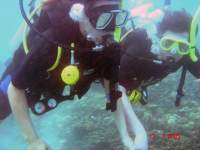G?day Mate!
Daly Waters ? Borroloola ? Hell?s Gate ? Burke and Wills ? Georgetown ? Innisfail ? Townsville ? Airlie Beach ? Gympie ? Brisbane ? Moreton Island ? Brisbane ? Byron Bay ? Taree ? Sydney!
30th April - 23rd May 2005
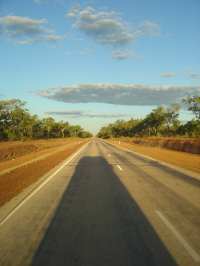 So we set off from Darwin with the sole aim of reaching Daly Waters for Alexis?s 29th birthday. We stocked up with water, food and petrol and started along the stunning Stuart Highway south. The sky was a brilliant blue with a few scattered clouds streaming across it, the pale green and white of the eucalyptus trees and the red soil of the outback were exactly what we were expecting but the colours were not ? they were so brilliant in strength. Due to the heat of the day there were many forest fires along the road. One particularly bad one we stopped to have a look at. It was rampaging along the side of the road, birds were running out, insects scurrying across the road and lizards darting away from the heat our whilst the kites circled above waiting to scavenge out the unfortunate cooked ones. A sad situation but when careless people throw cigarettes out the window it all becomes kindling wood. The fire brigade were out trying to stop other fires from spreading by controlled burning around the fires. Bill Bryson had written about Daly Waters in his book Down Under and so we had to visit it too. We reached Daly Waters after a 8 hour drive in a car that is lucky to stay under 40 oC, sweaty and hungry. We made straight for the bar! The Daly Waters Pub is something to be seen to be believed. Situated right next to the camp site, this backwater pub is the centre of the town and adorned with everything and notes from across the world. The walls are coated in t shirts, pictures, badges, stickers, signs, old agricultural machinery, the compulsory knickers and now a Beastly Adventure card. Dinner consisted of a pasty due to the kitchens being closed followed with an ice cold beer and a bottle of Aussie champagne! No better way to celebrate your birthday!
So we set off from Darwin with the sole aim of reaching Daly Waters for Alexis?s 29th birthday. We stocked up with water, food and petrol and started along the stunning Stuart Highway south. The sky was a brilliant blue with a few scattered clouds streaming across it, the pale green and white of the eucalyptus trees and the red soil of the outback were exactly what we were expecting but the colours were not ? they were so brilliant in strength. Due to the heat of the day there were many forest fires along the road. One particularly bad one we stopped to have a look at. It was rampaging along the side of the road, birds were running out, insects scurrying across the road and lizards darting away from the heat our whilst the kites circled above waiting to scavenge out the unfortunate cooked ones. A sad situation but when careless people throw cigarettes out the window it all becomes kindling wood. The fire brigade were out trying to stop other fires from spreading by controlled burning around the fires. Bill Bryson had written about Daly Waters in his book Down Under and so we had to visit it too. We reached Daly Waters after a 8 hour drive in a car that is lucky to stay under 40 oC, sweaty and hungry. We made straight for the bar! The Daly Waters Pub is something to be seen to be believed. Situated right next to the camp site, this backwater pub is the centre of the town and adorned with everything and notes from across the world. The walls are coated in t shirts, pictures, badges, stickers, signs, old agricultural machinery, the compulsory knickers and now a Beastly Adventure card. Dinner consisted of a pasty due to the kitchens being closed followed with an ice cold beer and a bottle of Aussie champagne! No better way to celebrate your birthday!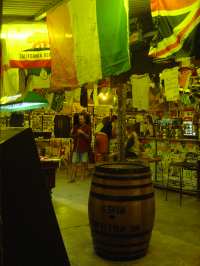
The stars in the outback are something else ? you can see the milky way and for any of you that have never been to the southern hemisphere, the stars are twisted slightly to the side but you can see the southern cross. The moon is also turn sideways and in Brasil is called George and the Dragon.
From Daly Waters we worked our way away from the Stuart Highway to Borroloola eliminating about 200km from our travel on the recommendation of teachers who we met in the campsite in Daly Waters. We drove down a beautiful road with more white and black eucalyptus trees lining the road, red soil and a clear blue sky. We had puncture and stopped to change it in the searing 34oC heat, hundreds of kilometres from the nearest town with a population of more than 50. We stopped to get drinks and fill up with petrol at the Heartbreak Hotel only to find that they had just run out of petrol. Luckily we had loaded up with petrol in our jerry cans ? an essential in the outback. Borroloola is in aboriginal territory and our campsite was conveniently located next to a pub. The pub is split into two and when we walked in we walked into the white side of the pub. It was rather like any pub you would imagine to be in any backwater and a little like the pubs from the Fosters adverts. There were men in there with their cowboy hats on leaning on the bar. There were signs up on the wall saying that you would be banned for life alongside the blackboard with the substantial list of people that were banned for life ? pretty good going to be banned for life from the only pub within a 100km radius!
From Borroloola we headed off down the Carpentaria Highway, a red dirt track with corrugated iron underneath to stop it washing away in the wet season. With the hidden dips on the dirt tracks you have to be aware of the ruts. Greg decided at one point to do a Duke?s of Hazard take off when accidentally hitting a double bump too fast, catapulting a three and a half tonne vehicle in the air, with the contents of every cupboard deciding to also empty themselves out. A following rut that jumped up at us left us with fast deflating tyre. We realised that we had no wood to support the jack ? Australian Quarantine had requested that we get rid of it before entering the country - and so gently lifted rocks (just in case any red backs decided to launch themselves at us) to get something to support the diff. The jack decided that it didn?t want stay on the rock and so the Beast lurched dangerously over to the side almost toppling off and crashing on top of us. We were lent a piece of wood by a passing bus driver (only the third vehicle that we passed along the way) and quickly changed the tyres over. We were left with no spare tyres and a distance of 150km on dusty red unsealed roads to go to the next point that we might be able to change our inner tubes. We carried on down the road seeing emus, our first kangaroos, humped back Brahman cows, dingoes, beautiful grey and pink as well as iridescent green parrots, frogs, snakes and all from inside the car. We passed through 2 foot deep creeks that had promises of crocodiles but luckily none that we saw.
We arrived in Hell?s Gate pleased to see habitation and a fridge full of ice cold beer, so much so that we dumped the Beast and ran to the pub! The showers were full of the most fantastic bright green tree frogs clambering to be near water. On flushing the toilet, Alexis jumped back with a scream as a tree frog?s legs dangled out from the rim and then climbed back up. All part of the
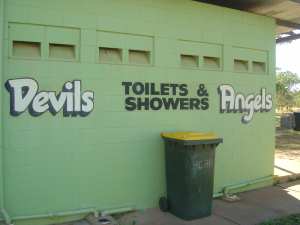 outback fun. Hell?s Gate was named after a gap in the hills located 2km south where the police used to escort settlers and aborigines into the jurisdiction of the Northern Territory Police, a mere 200km away. If you were escorted to Hell?s Gate it was a death sentence. Hell?s Gate now has a camp site, a station (farm), a restaurant and runway. The runway is used by the station and surrounding stations for refuelling before zooming off to round up cattle over the million plus hectares that some of the farms cover.
outback fun. Hell?s Gate was named after a gap in the hills located 2km south where the police used to escort settlers and aborigines into the jurisdiction of the Northern Territory Police, a mere 200km away. If you were escorted to Hell?s Gate it was a death sentence. Hell?s Gate now has a camp site, a station (farm), a restaurant and runway. The runway is used by the station and surrounding stations for refuelling before zooming off to round up cattle over the million plus hectares that some of the farms cover. From Hell?s Gate we headed down to Burke and Wills roadhouse, passing through Gregory Downs (stopping for the obvious pictures of Greg!). The roads improved from dusty ruts to dusty roads and then into dusty tarmac covered roads. Burke and Wills roadhouse was more of a pub than Hell?s Gate and we propped ourselves up at the bar and made some wonderful friends in the owner Bill and his manager. Ken, a long distance lorry driver, gave us a run down on the wildlife in Australia. The red wine flowed a bit too easily (at only #4 for a 4 litre box, you just have to indulge!) and red wine teeth and dribbles were quite rife! We dragged ourselves back to the Beast and awoke the following with a nice red wine hangover.
We headed towards the coast passing through the gold mining town of Croydon, stopping in Georgetown and then passing up onto the Atherton Tablelands. The Atherton Tablelands are located on the eastern part of Australia in the Great Dividing Range. We drove from the hot (34oC), dusty Barkly Tablelands up into the mountains where the temperature dropped to a chilly 19oC and the scenery changed to deciduous green forests with tree ferns and rolling green jersey cow strewn fields that vanished off onto the horizon.
 We experienced our first proper rain since Europe (Malaysia was quick rainstorms) as we dropped down onto the western ?Sunshine Coast?. We stopped at Inisfail before working our way down to Townsville where we met Sharon and Ken who fed a 100 strong troupe of Rainbow Lorikeets who would descend every day for their treat of sugar, bread and water.
We experienced our first proper rain since Europe (Malaysia was quick rainstorms) as we dropped down onto the western ?Sunshine Coast?. We stopped at Inisfail before working our way down to Townsville where we met Sharon and Ken who fed a 100 strong troupe of Rainbow Lorikeets who would descend every day for their treat of sugar, bread and water.We passed on down the monotonous Bruce Highway to Airlie Beach where we all went diving and sailing in the Whitsunday Islands. Adrian spent a week sailing around the Whitsunday Islands and doing a 4 wheel drive expedition around Fraser Island. Alexis and Greg headed down the coast passing through old mining towns, wine valleys and cheeseries all situated in the Glasshouse Mountains. The aim was to get to Brisbane in time for a relaxing week on Moreton Island courtesy of Greg?s parents. We found a garage in north Brisbane to resolve the final issues of the oil leak on the front tyre and found that we could have been doing three wheeling stunts down the motorway as the wheel nuts were slowly working their way loose. We bid our mechanics goodbye and headed across Moreton Bay to Moreton Island for a relaxing week away from driving. We took the Beast with us and experienced the most terrifying driving of our trip. We lowered the tyre pressure to help us drive on the sand. We drove off the boat onto the beach onto the third largest sand island in the world and immediately imbedded ourselves into the beach with every spin of the wheel digging us further into the sand. Panic hit thinking that a 3.5 tonne vehicle should not be on the sand, especially along the tide line and we thought we would have to leave her there, slowly sinking in the surf. Greg went and asked one of the many spectators gathering around us if they could tow us out and was met with a simple question of ? ?have you engaged low gear ratio???? Embarrassed we climbed back in, slipped it into low gear and headed off down the beach waiting to sink into the sea at every turn of the wheel. We were staying at the Tangalooma Wild Dolphin Resort were they had persuaded some wild dolphins that they were the marine equivalent of MacDonald?s as they offered them some fast fish evening snacks. They practically beached themselves to be fed the delights of the surf (along with a few human fingers!). They were being monitored by the Marine Research centre who had persuaded a pod of 10 to regularly visit them. There were also other contacts with nature as the local Kookaburras came swooping down for food, Pelicans were fed daily on the golden sands and the fish all swarmed around the jetty to grab morsels thrown to them. A total of 15 ships have been purposefully sunk off the shore to create a reef that you can snorkel around the mangled rusty metalwork and see multi coloured fish darting about being chased by dolphins and turtles. A fantastic and beautiful island.
From Moreton Island we headed back onto the mainland and then hit the motorway. We drove south stopping at a very rainy but stunning Byron Bay and then down to Sydney where Alexis met up with her cousin Jenny and her wonderful family. At Sydney we are all separating for different cities to earn enough money for the next leg of the journey. Alexis and Greg have headed back to the UK for a month for family hen parties and weddings before heading down to Melbourne to work. Adriano is staying in Sydney to continue his Masters in Linguistics. Updates will be fewer than normal from now on ? you can have a rest from reading about our adventures and get back to the reality of life for a while. We will reactive your wandering tendencies when we get back on the road in 6 months or so. If you want to read about others that are venturing around the world, this webpage may give you the kick to go and explore - Africa Overlandhttp://www.africa-overland.net/world.html. In the meantime, please write to us and tell us what you are upto. Thanks for still reading!
Notes about Australia:
- There are two types of sim cards in Australia ? the GSM card which will only work in towns and the other card which works right out in the middle of nowhere.
- There are pubs that are segregated into two parts, with a white and aborigine side to the pub. This is not an apartheid type of segregation it is just that the aborigine drinkers prefer to get very drunk without the white drinkers about.
- There are hundreds of termite mounds along the side of the road in the outback.
- The Northern Territory covers an area of 523,000 miles ? 1/5th of the country
- The Northern Territory has no say over the politics of Australia as they did not sign up to become Australia?s seventh state. All Australians are required to vote in elections but they elect representatives who cannot vote.
- Geologically, Australia is undiscovered. The geological survey has hardly surveyed any of the country due to its harsh environments. Many mineral mines were only discovered in the mid 20th century.
- Australia has around 25,000 species of plants ? that have been identified so far (the UK has 1,600 species).
- In Western Australia, the divorce rate is 1 in 2 (it is 1 in 3 in the UK).
- About 80% of the population live on the east coast.
Posted by Alexis
at 12:01 AM BST
Updated: Friday, 3 June 2005 5:55 PM BST
Permalink | Share This Post
Updated: Friday, 3 June 2005 5:55 PM BST
Permalink | Share This Post



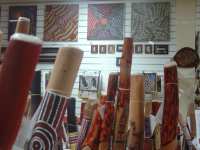 100,000 people which drops by 15,000 people in the wet season as people head towards the sun and a drier atmosphere. Temperatures in the wet season soar and the atmosphere gets very sticky. Darwin has suffered badly over the past since it was established in 1869. The Japanese carried out mass bombings of Darwin in 1942 and over 30,000 people were evacuated from the city. When Cyclone Tracy hit in 1973 it completely wiped out most of the buildings in the town, leaving a new ?70s town in its place with faceless grey and white buildings. The World War II air raid shelters and tunnels are still in place and can be visited but Greg and Alexis indulged themselves in the Deckchair Cinema, an open air cinema, looking out onto the bay and lounging on deckchairs you can enjoy
100,000 people which drops by 15,000 people in the wet season as people head towards the sun and a drier atmosphere. Temperatures in the wet season soar and the atmosphere gets very sticky. Darwin has suffered badly over the past since it was established in 1869. The Japanese carried out mass bombings of Darwin in 1942 and over 30,000 people were evacuated from the city. When Cyclone Tracy hit in 1973 it completely wiped out most of the buildings in the town, leaving a new ?70s town in its place with faceless grey and white buildings. The World War II air raid shelters and tunnels are still in place and can be visited but Greg and Alexis indulged themselves in the Deckchair Cinema, an open air cinema, looking out onto the bay and lounging on deckchairs you can enjoy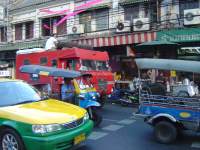 market). We sat in stationary traffic for an hour before we managed to struggle across the city. We were told to expect Moscow driving but were pleasantly surprised by the courteousness of the drivers who let us into the correct lane after we had to weave our way across the traffic to get to the exit.
market). We sat in stationary traffic for an hour before we managed to struggle across the city. We were told to expect Moscow driving but were pleasantly surprised by the courteousness of the drivers who let us into the correct lane after we had to weave our way across the traffic to get to the exit. 